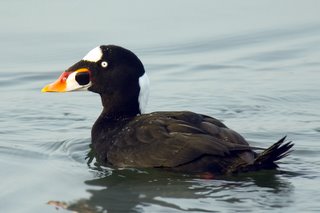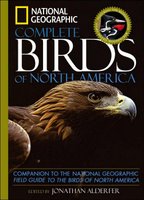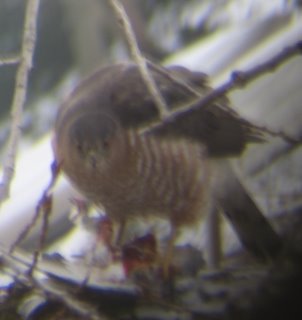Surf Scoter at North Point Marina
Winthrop Harbor, Illinois
Sunday, February 26, 2006, 1115am
I overslept this morning after watching a movie late with Lynne last night. So instead of getting a reasonable start to my birding day, I only had until about 2pm, I didn't get out the door until 945am. The plan for the day was to visit Van Patten Woods, North Point Marina and Independence Grove. I was especially interested in seeing the larger groups of Snow Geese that had been reported in these areas, as well as the Surf Scoters at North Point Marina, and Sandhill Cranes moving north that had stopped over at Van Patten.
It was a beautiful morning and instead of the very cold weather predicted earlier in the week, it was clear, sunny and not impossibly cold. On the way north, I needed gas, so I thought I would swing by the Skokie Lagoons to see what I could see; Ring-billed Gulls, Canada Geese, a single male Hooded Merganser and three or four Common Goldeneye. I was focused on getting north, so instead of tromping around there, I kept moving north.
On the way I was optimistic about what the day would hold as I saw three Red-tailed Hawks, and one other hawk that likely wasn't a Red-tailed between the I94/294 merge and my exit at 173. I wasn't even really looking. I had never been to Van Patten Woods, so I drove around the whole place with occasional stops to survey the landscape; Canada Geese, Snow Geese and a group of gulls. It looked like a ground burn was recently done in some areas at Van Patten, and I wondered what that would mean for the woods later in the summer.
From there it was a short drive to Winthrop Harbor. Now to find the Surf Scoters. As I was pulling up, a few guys with scopes were packing up, and I caught them in time to ask if they had seen anything of note I should keep an eye out for. They were birders who had attended the Gull Frolic there a few weeks back, and though they weren't overly detailed in their feedback, I did learn that the reported Snow Buntings had not been seen for a few days, and that the Surf Scoters were across the harbor with a group of ducks.
A duck hunting we will go. I love North Point Marina, and that doesn't even include the gulls which I didn't even try to look at today as I don't yet have a scope. Immediately I saw American Coots, Redheads, Common Goldeneyes, Hooded Mergansers, Buffleheads, Mallards, Canada Geese and scaups in more or less four different groups. Though I was looking for the Surf Scoters, it was great to watch the Common Goldeneye males displaying, and the Buffleheads were very active. The Redheads seemed so brilliantly colored with the sun on them from the south.
 Once I got to the group of ducks out at the mouth of the harbor I began looking over this, the largest group of ducks, more carefully. Ugh, these ducks were just a bit too far away. I could pick out the Goldeneyes and Scaups, but where were the Surf Scoters (photo Matt Fletcher)? After 30 minutes with my 8.5x44 Swift Audubons, I could pick out two birds that were not like the others. Dark, bodies, one had a white patch on the back of its head/neck, and both had tail feathers pointed upward in a manner that was distinctly different than all the other birds out in this group.
Once I got to the group of ducks out at the mouth of the harbor I began looking over this, the largest group of ducks, more carefully. Ugh, these ducks were just a bit too far away. I could pick out the Goldeneyes and Scaups, but where were the Surf Scoters (photo Matt Fletcher)? After 30 minutes with my 8.5x44 Swift Audubons, I could pick out two birds that were not like the others. Dark, bodies, one had a white patch on the back of its head/neck, and both had tail feathers pointed upward in a manner that was distinctly different than all the other birds out in this group. But neither would pick their head up so I could see their faces and bills. How long could I wait them out? Shortly helped arrived in the form of fellow birders Matt F and Kanae H. Kanae had her scope, and after she set it up, we got a great look at the birds, but they still wouldn't show their faces. We exchanged introductions, stories and plans for the day, and waited for them to show their pretty faces. I was the lucky one that got to see them through the scope for the 8-10 seconds they lifted their heads, showed their faces and bills, and gave me the confirmation necessary to add bird #84 to my list, bird #66 for Illinois. It was worth the wait. I felt thrilled to see both the male and female.
But neither would pick their head up so I could see their faces and bills. How long could I wait them out? Shortly helped arrived in the form of fellow birders Matt F and Kanae H. Kanae had her scope, and after she set it up, we got a great look at the birds, but they still wouldn't show their faces. We exchanged introductions, stories and plans for the day, and waited for them to show their pretty faces. I was the lucky one that got to see them through the scope for the 8-10 seconds they lifted their heads, showed their faces and bills, and gave me the confirmation necessary to add bird #84 to my list, bird #66 for Illinois. It was worth the wait. I felt thrilled to see both the male and female.As we were all leaving and getting in our cars, I noticed my neighbor Karen was on the other end of the parking lot about to leave too. I thanked her for the guidance on the Screech Owls the day before. She was heading off to see some Pine Siskins at Illinois State Beach. We stopped at Sand Pond, and then the Nature Center at the south entrance, to which I had never been before. It was very quiet except for an American Robin, and I must say the best sighting of the day was the skyscrapers of the Chicago skyline from 50 miles away while we were down at the beach.
Unfortunately, that would pretty much be it for the day. Independence Grove was empty save for gulls and Canada Geese. On the way to the Grove I spotted a Red-Shouldered Hawk which I pulled off to the side of the road to watch for 5 or so minutes until it flew away. From the Grove to home, I saw 7 more Red-tailed Hawks on the side of the interstate including one all the way down at Peterson, something I don't typically see. Usually the last ones I see are on the spur right before 94 merges with 41. Today, I saw two after that point, the second was at Skokie Lagoon.
It wasn't the day of racking up a few new species I had hoped it would be, but I did add one new find;
#84 SURF SCOTER both male and female






























